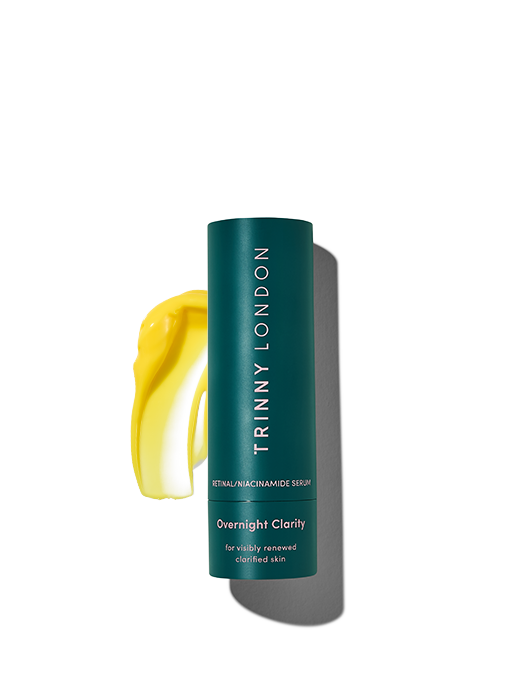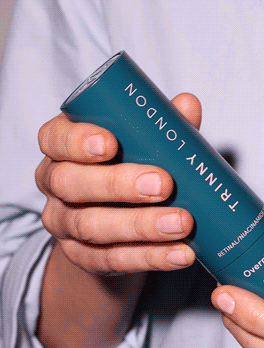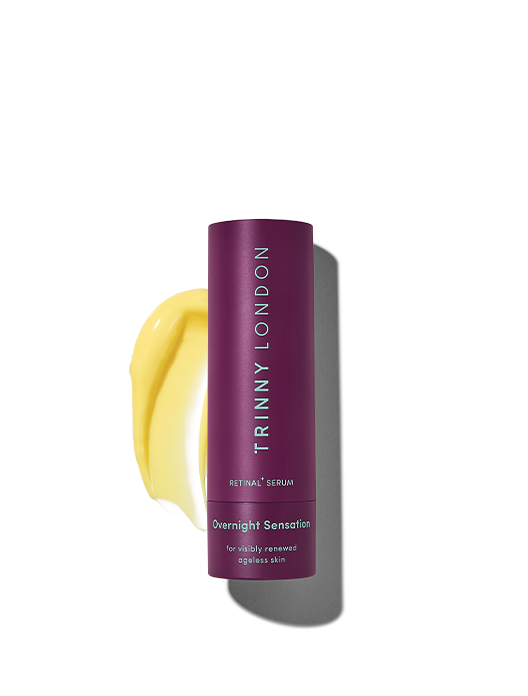

Overnight Clarity
Retinal/niacinamide serum for visibly smooth, youthful skin, suitable for all skin types

retinal, retinol, retinyl – navigating the wonderful world of retinoids can feel like a minefield
There’s so much confusion around this hero ingredient, much of which stems from the fact that when most people or brands say retinol, they are in fact referring to a family of ingredients called retinoids. All of the different types of retinoid have different names, strengths and levels of irritation. They include retinoic acid, retinal and retinol.
A good way to picture this is to think of retinoids like cheese. Cheese is one category, but there are many versions within it with varying strengths. For example, most people like cheese in general, but not everyone can tolerate a stinky stilton, and some might prefer a milder edam.
All retinoids are derived from vitamin A. The body can’t make its own vitamin A, so it comes from our diet from foods like leafy green vegetables, carrots and eggs. But, before you start stockpiling spinach, it’s important to note that although eating foods rich in vitamin A will benefit our bodies, it won’t have a noticeable impact on our skin. Our bodies prioritise our vital organs (and rightly so) meaning that skin is right at the back of the queue. For this reason, to really reap the complexion-boosting benefits of retinoids, they’re best applied topically.
Retinoids were initially used to treat acne in studies dating back to the 1940s, and it was through this that scientists also noticed its impressive anti-ageing benefits. They have been commonly used to treat skin texture and fine lines since the 1980s.
Often hailed as skincare miracle-workers, retinoids boast an impressive list of skin-boosting benefits.
Our skin’s supply of collagen (the proteins which give skin its bounce and structure) deplete as we age, leading to a loss of fullness and sagging. Retinoids jump-start the dwindling production of collagen, helping skin to replenish its lost stocks. Think of it like giving your cells a shot of coffee, supercharging them to work more efficiently.
As we age, the natural rate at which our skin cells turn over starts to slow, meaning skin that was previously fresh and glowing looks less like shiny marble and more like a murky window in need of a clean. Retinoids speed up the process of cell turnover, so skin behaves more like its younger self. Skin appears brighter, with pigmentation fading over time. Retinoids also block the transportation of melanin (the pigment that gives skin its colour) to prevent future age spots from forming.
Another benefit of an increase in cell turnover is a decrease in breakouts. Pores are less likely to become blocked if the top level of the skin is being consistently resurfaced. Think of it like the top of a cabinet: if you dust it everyday, there's no opportunity for grime to build up. Retinal, in particular, also has antibacterial properties.
Retinoids are a bit bossy. They do a brilliant job of getting skin cells to behave better and work in balance. With harmony restored, skin is better able to defend itself from external stressors, and does a better job of holding on to much-needed moisture.
Retinoids vary in strength, and are categorised by how many conversions they take to become retinoic acid. The different types of retinoid are:
Retinoic acid: The highest strength of retinoid in its fully active form. It is available via prescription only.
Retinal (also known as retinaldehyde): The second highest strength, this requires just one conversion step to become retinoic acid. It converts when it is inside the skin, meaning it causes less irritation than…
Retinol: The third highest strength, retinol requires two conversions to become retinoic acid. It is the most widely used form of retinoid in the cosmetics market. But, as it starts to convert to retinoic acid on the surface of the skin, it is most likely to cause irritation.
Retinol esters: The weakest form of retinoids. This term refers to retinoids combined with other compounds. They require the highest number of conversions to become retinoic acid, and have the prefix “retinyl”.
Seperate to this are retinoic acid esters like hydroxypinacolone retinoate. Instead of converting into retinoic acid, retinoic acid esters bind directly to the retinoic acid receptors that exist in our skin. For this reason, they cause less irritation. Retinoic acid esters are newer ingredients and more expensive to formulate with, hence why they are not as widely used.
As a general rule, we would recommend each form of retinoid for the following skin types:
- Retinal: Normal/blemish-prone skin
- Retinol: Normal/oily skin that is able to tolerate strong actives
- Retinol esters: Sensitive or dry skin
- Retinoic acid esters: Most skin types
Retinoids are not suitable for women who are pregnant.
Realistically, you don’t need to start using retinoids until you begin to notice fine lines and wrinkles. For most people, this will be around their late 20s to early 30s. We know prevention is better than cure, but fine lines only begin to form when collagen production and cell turnover slow. So using a retinoid before this point won’t have much of an impact. Think of it like wearing a pair of high-waisted shapewear shorts when you have a flat stomach.
A caveat to this is if you’re suffering from acne. In these instances, those in their teens and twenties may be given a prescription-strength retinoid like tretinoin from their doctor.
As retinoids speed up cell turnover, they can cause irritation like redness and flaking in the first instance. This is as our skin is adjusting to its new way of working, and any side effects should clear up within one week. Think of it like going to the gym for the first time in years. You’d expect your muscles to feel sore initially while you get back up to speed.
The best retinoid products are the ones that have been formulated with soothing ingredients to counteract any potential irritation. Or, better yet, use a type of retinoid that won’t cause any irritation in the first place.
A very important thing to remember when using retinoids is that they make skin more sensitive to light. It is therefore crucial to protect your skin with an SPF of at least 30 during the day time. Using retinoids and not wearing SPF is like getting a blow-dry and then going out in the rain without an umbrella – it will undo your hard work and leave your skin with more problems than it started with.
Technically, all skin types should be able to tolerate a retinoid, it just depends on the strength, the type of retinoid used and the formulation. You might need to shop around and sample different types to find the right one for you.
As always, there are caveats here. If your skin is already inflamed due to extreme dryness or conditions such as rosacea, eczema or psoriasis, then it's more likely to react to a retinoid.
Retinoids are also not recommended for women who are pregnant or breastfeeding, as retinoic acid has been proven to cause birth defects. As always, it’s best to err on the side of caution.
Retinoids should only be used at night for three key reasons. Firstly, it oxidises in sunlight, which will reduce its potency. Secondly, retinoids make skin more sensitive to light, so wearing them during the day is a bad idea. Finally, our skin is not exposed to external factors, like pollution and UV as we sleep, so we can fully reap the benefits with minimal distraction. Think of it like trying to read a book in a quiet room vs a packed train carriage.
As with all ingredients, if you’re new to retinoids, you need to build up your usage slowly and carefully while listening to your skin. Start with a twice a week application, increasing only if your skin is reacting well. If you go in with high strengths and regular application, you’re much more likely to suffer adverse side effects.
If you do find that your retinoid causes irritation, consider buffing its application by applying moisturiser before and after. And again, remember your SPF during the day.
Bakuchiol is often touted as a more natural alternative to retinoids, as they have similar benefits. However, they work in very different ways. At the moment, bakuchiol has not been as widely researched as retinoids, so it is difficult to make like-for-like comparisons. So, if you want to spend your money on a wrinkle-smoothing product with confidence, retinoids are a better bet.
However, bakuchiol doesn’t carry the same health warnings as retinoids, and can be used by those who are pregnant or breastfeeding. If this applies to you, go down the bakuchiol or peptide route instead.


Retinal/niacinamide serum for visibly smooth, youthful skin, suitable for all skin types

High-dose retinal serum for renewed, ageless skin, suitable for all skin types